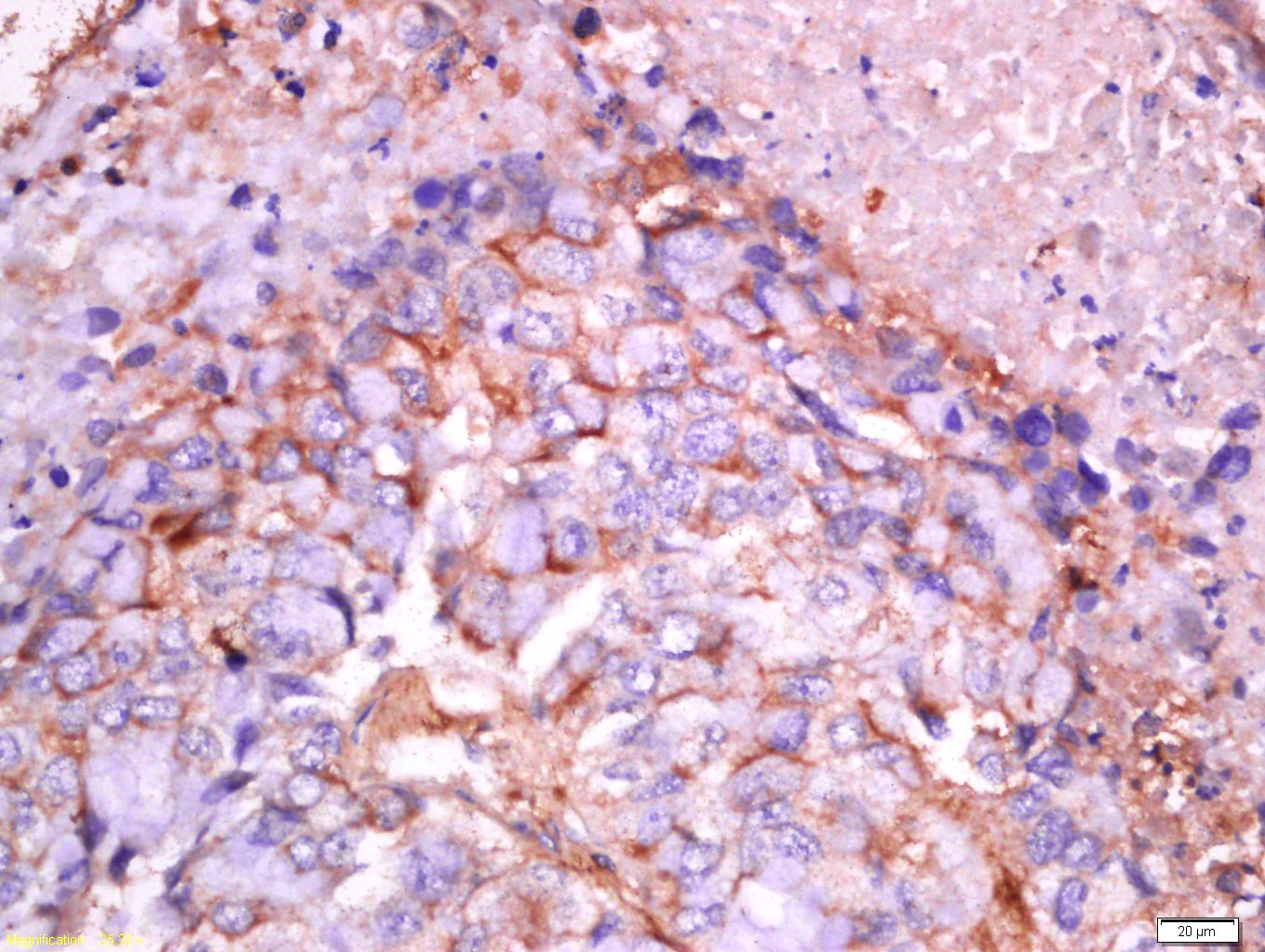
Rabbit Anti-phospho-EphB1+EphB2 (Tyr594)antibody
Eph receptor B1 + Eph receptor B2 (phospho Y594); p-Eph receptor B1 + Eph receptor B2 (phospho Y594); Eph receptor B1+Eph receptor B2; EPH B1; EPH B2; Eph tyrosine kinase 2; Eph tyrosine kinase 3; EPHB1; EPHB2; Ephrin receptor EphB1; Ephrin receptor EphB2
View History [Clear]
Details
Product Name phospho-EphB1+EphB2 (Tyr594) Chinese Name 磷酸化酪氨酸蛋白激酶受体B1+B2抗体 Alias Eph receptor B1 + Eph receptor B2 (phospho Y594); p-Eph receptor B1 + Eph receptor B2 (phospho Y594); Eph receptor B1+Eph receptor B2; EPH B1; EPH B2; Eph tyrosine kinase 2; Eph tyrosine kinase 3; EPHB1; EPHB2; Ephrin receptor EphB1; Ephrin receptor EphB2; Ephrin type B receptor 1; Ephrin type B receptor 2; EPHT 2; EPHT 3; ERK; Hek 5; Hek 6; Tyrosine protein kinase receptor EPH2; Tyrosine protein kinase receptor EPH3. Product Type Phosphorylated anti Research Area Cardiovascular Cell biology Neurobiology Signal transduction Kinases and Phosphatases The cell membrane受体 Immunogen Species Rabbit Clonality Polyclonal React Species Human, (predicted: Mouse, Rat, ) Applications WB=1:500-2000 ELISA=1:5000-10000 IHC-P=1:100-500 IHC-F=1:100-500 ICC=1:100-500 IF=1:100-500 (Paraffin sections need antigen repair)
not yet tested in other applications.
optimal dilutions/concentrations should be determined by the end user.Theoretical molecular weight 110kDa Cellular localization The cell membrane Form Liquid Concentration 1mg/ml immunogen KLH conjugated synthesised phosphopeptide derived from human EphB1+EphB2 around the phosphorylation site of Tyr594: KI(p-Y)ID Lsotype IgG Purification affinity purified by Protein A Buffer Solution 0.01M TBS(pH7.4) with 1% BSA, 0.03% Proclin300 and 50% Glycerol. Storage Shipped at 4℃. Store at -20 °C for one year. Avoid repeated freeze/thaw cycles. Attention This product as supplied is intended for research use only, not for use in human, therapeutic or diagnostic applications. PubMed PubMed Product Detail Ephrin receptors bind members of the ephrin ligand family. They are divided into 2 groups based on the similarity of their extracellular domain sequences and their affinities for binding ephrin-A and ephrin-B ligands. They make up the largest subgroup of the receptor tyrosine kinase (RTK) family. Eph receptor B1 (EphB1) and Eph receptor B2 (EphB2) are receptors for ephrin-B family members. Developing and adult neural tissue express nearly all of the Ephrin receptors and ephrin ligands. Ephrins and ephrin receptors also play a significant role in angiogenesis. EphB2 acts as a tumor suppressor.
Function:
Receptor tyrosine kinase which binds promiscuously transmembrane ephrin-B family ligands residing on adjacent cells, leading to contact-dependent bidirectional signaling into neighboring cells. The signaling pathway downstream of the receptor is referred to as forward signaling while the signaling pathway downstream of the ephrin ligand is referred to as reverse signaling. Cognate/functional ephrin ligands for this receptor include EFNB1, EFNB2 and EFNB3. During nervous system development, regulates retinal axon guidance redirecting ipsilaterally ventrotemporal retinal ganglion cells axons at the optic chiasm midline. This probably requires repulsive interaction with EFNB2. In the adult nervous system together with EFNB3, regulates chemotaxis, proliferation and polarity of the hippocampus neural progenitors. Beside its role in axon guidance plays also an important redundant role with other ephrin-B receptors in development and maturation of dendritic spines and synapse formation. May also regulate angiogenesis. More generally, may play a role in targeted cell migration and adhesion. Upon activation by EFNB1 and probably other ephrin-B ligands activates the MAPK/ERK and the JNK signaling cascades to regulate cell migration and adhesion respectively.
Subunit:
Heterotetramer upon binding of the ligand. The heterotetramer is composed of an ephrin dimer and a receptor dimer. Oligomerization is probably required to induce biological responses. Interacts with EPHB6; transphosphorylates EPHB6 to form an active signaling complex. Interacts with PICK1. Interacts (through Tyr-594) with NCK1 (via SH2 domain); activates the JUN cascade to regulate cell adhesion. The ligand-activated form interacts (through Tyr-928) with GRB7 and GRB10 (via SH2 domains). The ligand-activated form interacts (residues within the catalytic domain) with GRB2 (via SH2 domain). Interacts with GRB2, SHC1 and SRC; activates the MAPK/ERK cascade to regulate cell migration. Interacts with CBL; regulates receptor degradation through ubiquitination. Interacts with ACP1.
Subcellular Location:
Cell membrane; Single-pass type I membrane protein. Early endosome membrane. Cell projection, dendrite.
Tissue Specificity:
Preferentially expressed in brain.
Post-translational modifications:
Phosphorylated. Autophosphorylation is stimulated by the ligand EFNB1. Required for interaction with SH2 domain-containing interactors, for activation of the MAPK/ERK and JUN signaling cascades and for ubiquitination by CBL.
Ubiquitinated; (EFNB1)ligand-induced poly- and/or multi-ubiquitination by CBL is regulated by SRC and leads to lysosomal degradation.
Similarity:
Belongs to the protein kinase superfamily. Tyr protein kinase family. Ephrin receptor subfamily.
Contains 1 Eph LBD (Eph ligand-binding) domain.
Contains 2 fibronectin type-III domains.
Contains 1 protein kinase domain.
Contains 1 SAM (sterile alpha motif) domain.
SWISS:
P54762
Gene ID:
2047
Database links:Entrez Gene: 2047 Human
Entrez Gene: 270190 Mouse
Omim: 600600 Human
SwissProt: P54762 Human
SwissProt: Q8CBF3 Mouse
Unigene: 116092 Human
Unigene: 22897 Mouse
Unigene: 46606 Rat
Product Picture
Antigen retrieval: citrate buffer ( 0.01M, pH 6.0 ), Boiling bathing for 15min; Block endogenous peroxidase by 3% Hydrogen peroxide for 30min; Blocking buffer (normal goat serum,C-0005) at 37℃ for 20 min;
Incubation: Anti-EPHB1 Polyclonal Antibody, Unconjugated(SL10781R) 1:200, overnight at 4°C, followed by conjugation to the secondary antibody(SP-0023) and DAB(C-0010) staining
Bought notes(bought amounts latest0)
No one bought this product
User Comment(Total0User Comment Num)
- No comment



 +86 571 56623320
+86 571 56623320
 +86 18668110335
+86 18668110335

